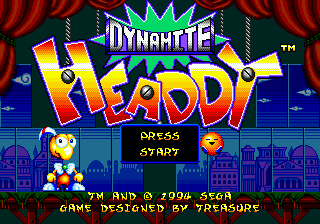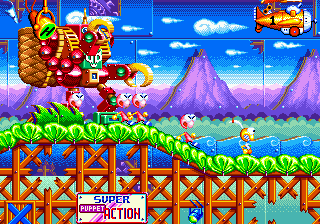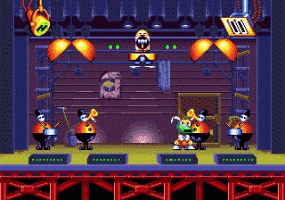Dynamite Headdy Review!
This is my review of Dynamite Headdy, a gem of a platforming game made by Treasure for the Sega Genesis. (I'm aware it's also on other consoles, but this review is exclusively for the Genesis port.) Also note this review is regarding the International release, which does have some differences from the Japan version of the title.
Graphics -=-=> 9
Treasure is no stranger to incredible graphics, having worked on titles like Gunstar Heroes and in the N64 era, Mischief Makers. They also worked on McDonald's Treasure Land Adventure, a game that also sports a lot of vibrant colors and animated graphics.
The color palette is very vibrant and without a doubt takes advantage of as many chances it can get to show off a variety of displays.
Something to note is that some graphics (most notably bosses) were changed between the Japan and international releases, but they do not change gameplay elements.
Most of the game follows a theme of 'theatre' and toys, adding to the 'goofy' and 'non-serious' nature of the game.
Sound -=-=> 9
There are a wide variety of sound effects used, though none of them feel too intrusive. (Save for the TARGET! sound effect when it's spammed, but this only happens in the tutorial stage)
The game's music is quite impressive for the hardware, and none of it gets too grating on the ears or distracts too hard from whatever is going on the screen.
Addictiveness -=-=> 6
Dynamite Headdy doesn't really have HUGE replay value other than trying to get all the secret points in a run or attempting for the highest score.
There IS a super secret boss if you manage to beat all the bonus stages, similar to Sonic games, though it isn't required to get the 'true' ending. You're rewarded with numbers for a password after beating a bonus stage, and after the final main boss you can input them to get the secret level.
Outside of that, the main addictive aspect of this game comes from the over the top visuals and game play, I suppose. What's weird about going for high scores is that you only get to see your total and current score values AFTER beating a stage, and as such you have no idea where you stand before the curtains fall.
This is a fun game to show friends who haven't heard of it or played it, as there isn't too steep of an entrance learning phase, though that will only last for so long.
Story -=-=> 6
You play as Headdy, a puppet with the ability to throw his head like a projectile. The story is pretty basic (There isn't much dialog if any for major cutscenes in the International release), in that you must put a stop to the evil Daemon(?) Puppet(?) King, who is kidnapping toys and denizens of the world to gain control over it. It seems like he's also choosing who gets to live and who gets destroyed, as briefly suggested in one of the opening cutscenes.
Headdy manages to escape the 'dump shuttle' that was prepared to toss him and a handful of similar looking puppets into the incenerator, and the story starts from there.
Your main goal is to get to the final stage, defeat the evil King, and restore peace to the Toyland.
Throughout the acts you will fight minibosses and end bosses, generally thematic to whatever the stage's gimmick or theme is.
Depth -=-=> 9
The game is 100% linear in how it plays out, as you do not have alternate routes to take to the ending or 'extra' worlds outside of the ending secret level.
You play through each Act in a similar fashion, generally going from the left of the map to the right. (There are some stages which are more vertical, so bottom to top).
----
Controls
The platforming aspects of this game primarily revolve around the use of Headdy's... well, throwable head! You can throw your head with the B button, and it can be aimed by moving your D-pad right as you press the B button to throw his head.
One thing to note is you cannot throw it directly down below you unless you are airborne. Otherwise you are able to aim Headdy's head in 8 directions, which is used to collect power-ups, perform platforming, and attack enemies.
There is a sort of 'cool down' to his head in that you cannot just spam it endlessly, it has to actually return to his body before you can use it again. There is a few exceptions to this however, such as the 'shoot em up' flying stage, and the 'Pig Head' powerup that turns your normal attack into spammable (but lower damage) homing stars.
---
Stage Gimmicks
Treasure is an absolutely amazing and ambitious company, and it tried its hardest to wow everyone in its early years.
Each stage of Dynamite Headdy has its own stage gimmicks and theme, but in a fortunate twist, none of them feel out of place or work against the main platforming aspect of a throwable head.
To some people having tons of gimmicks would feel like they can't decide on what they want to settle on or that they are stretching their ideas thin but in reality Dynamite Headdy's biggest strength is that every stage gets its own identity and ends up being more memorable because of the gimmicks.
I've only played this game twice, but I still remembered the general gist of certain stages and bosses.
After the tutorial in the first stage teaching you the main 'trio' of helpful characters, the game goes absolutely wild with its attempts to get the most use out of basic ideas like points you can grapple to, powerups that affect your platforming abilities, and where you need to focus attention to during boss fights.
There are even a handful of fourth wall breaks where bosses can interact with off-stage elements, such as grabbing a 'powerup' box for you to utilize or swatting away the character who tells you their weakpoint.
Difficulty -=-=> 8
There's one thing that needs to be addressed first and foremost. The International release of Dynamite Headdy is significantly more tough than the Japan version of the game, and if you were to watch footage of or play the Japan version yourself you would pick up on them as early as the first 'boss'.
There are additional hitboxes for things that previously didn't have any in the Japan release, certain bosses are less likely to do things that would make defeating them faster, and so on.
Some bosses have double the health that they normally would have in the Japan release! Most notable is the final boss, and the 'Gatekeeper' robot. These fights feel like they go on longer than they should, even if you do manage to get their patterns down.
One of the more frustrating bosses for the International release is the 'Twin Freaks' boss, which utilizes a gimmick in which the stage must be flipped upside down (and vice versa) to help traverse an auto-scrolling segment while you fight the boss.
In the International release of this game, this boss has less total health than the Japan release. However, this comes with a much more nasty tradeoff - The hitbox for him to take damage from is considerably smaller than the Japan release, making the boss fight way harder than it needs to be. This would be fine if there was more warning or the camera was zoomed out to allow you to see what was coming up next on the map to prepare for when to flip, but that is not the case in either version of the release.
Another big difference in difficulty for the International version of this game is that you do not start with any continues. Just two lives, and that's it. You have to earn continues / lives yourself. This is very apparent when trying to make it to the final handful of stages, because some bosses can feel cheap compared to earlier ones. There is no password select or saving for your progress, so making it to the final boss is a feat itself.
Unlike Mega Man or other 'old and hard' games of the era, there is no way to change difficulty even on the start screen. Just the controls and that's it.
OVERALL SCORE: 8.4
This game's greatest strengths are the graphics, soundtrack, and the lengths that the developers expand upon and explore the gameplay mechanic of using your head for platforming and attacking. The difficulty on the International release might scare unsuspecting or unaware players away, especially since you do not start with continues on that version.
I'd say this is one of those games that you beat once or twice and then don't think too hard about later. Completing it for '100%' isn't too hard to do on your first run either, as long as you remember to have a pen and paper ready to input your secret password after the final boss.
|


 User Notice
User Notice 








